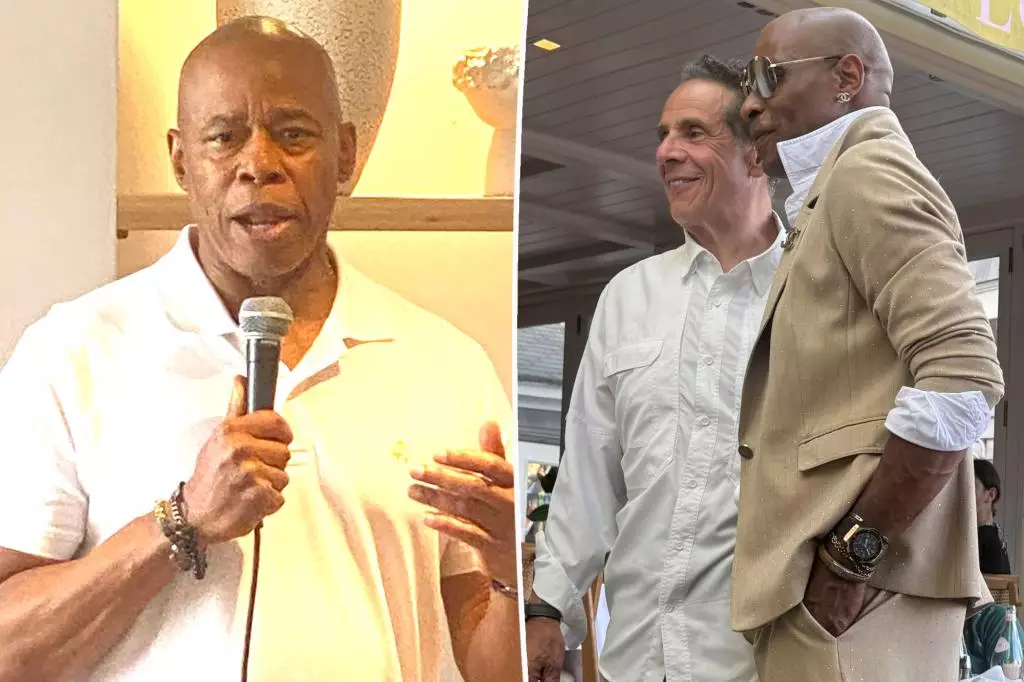Traditionally perceived as a sanctuary for the wealthy seeking leisure and escapism, the Hamptons has unmistakably become a crucible of political maneuvering in recent times. The recent weekend events demonstrated that prominent figures like Eric Adams and Andrew Cuomo are leveraging this upscale enclave not only for relaxation but also for subtle yet intense political messaging. This convergence of power underscores a pivotal shift: the Hamptons is transforming into a strategic platform where alliances are tested, rivalries are sharpened, and future electoral battles are subtly played out amidst luxury estates and exclusive gatherings.
These meetups are far from coincidental. They serve as stage settings for high-profile networking, fundraising, and cautious positioning. As Adams courts voters and donors, Cuomo is covertly contemplating a comeback, all amid whispers and public sightings that hint at a broader chess game aimed at redefining New York’s political landscape. The scene is set not merely for socializing but for the crafting of narratives and alliances that could determine the city’s leadership for years to come.
The Power of Symbolism: Adams’ Rhetorical Strategy in the Hamptons
Eric Adams’s recent appearance at the Fishel estate and his fiery speech at the Southampton breakfast illustrate a calculated use of symbolic messaging. Invoking hockey legend Wayne Gretzky—the “Great One”—Adams endeavored to frame his campaign as a resilient, team-first battle. By referencing Gretzky’s grit, Adams likened his political fight to a team battered yet unbreakable, emphasizing resilience in the face of scandal and public scrutiny.
More striking is Adams’ focus on ‘keeping New York safe’ and his vocal opposition to what he perceives as “far-left ideologies.” His remarks seem designed to energize moderate, business-minded voters who might be wary of progressive policies they see as threatening economic stability and order. Moreover, Adams’s pointed critique of Democrat Zohran Mamdani—and his assertion that Mamdani’s proposals are “dead-enders”—reveal a strategic move to consolidate his base as the true defender of pragmatic governance, contrasting himself sharply against the more radical edges of the Democratic spectrum.
Adams’s gesture of personally thanking restaurant staff reflects an intent to project humility and solidarity with everyday workers, contrasting sharply with typical political arrogance. This personal touch is designed to evoke warmth and approachability, traits often undervalued in political campaigns battling scandals and accusations of mismanagement. Yet, despite these efforts, there’s an undeniable undercurrent of defiance—Adams signals he’s prepared to fight to the bitter end, positioning himself as the unwavering candidate committed to “winning for them,” his base and the city’s ordinary workers.
Cuomo’s Shadow: The Silent Return and Quiet Reconsideration
While Adams strides confidently through the Hamptons, Andrew Cuomo remains a lurking presence, genetically tied to the area by history, influence, and recent sightings. His weekend appearance at the same upscale eatery and attendance at high-end parties serve as signals of a potential political reentry or at least an effort to stay relevant in a city still grappling with his controversial departure. His presence signals an ongoing calculation: Should he try to return to the political forefront, or is this merely a bid to stay in the conversation?
Cuomo’s repeated appearances around the city and in familiar social circles suggest more than casual visits. They hint at a strategic recalibration—testing the waters, maintaining connections, and possibly positioning for a future bid in the looming mayoral race. The fact that a recent poll places Cuomo ahead of Adams by double digits in hypothetical matchups exemplifies his lingering influence and the persistent questions about his political viability.
Despite distancing himself publicly during the weekend, Cuomo’s subtle moves reflect a man who has not abandoned his ambitions. His attendance at prominent liberal and business events, coupled with supportive whispers about his concern for New York City’s future, signals he remains an active player behind the scenes. The question is whether he will fully re-engage or remain a shadowy figure weighing policy incentives versus scandal fatigue.
The Stakes Are Higher Than Ever: Power, Perception, and Political Survival
This weekend’s juxtaposition of Adams and Cuomo encapsulates a broader narrative: the battle for New York’s future is not only about policies but also about perceptions, resilience, and the control of political storytelling. Adams is actively framing himself as the steadfast protector of New Yorkers, rallying support through emotional appeals and symbolic gestures. Meanwhile, Cuomo remains a potent alternative, a reminder of a different path, possibly representing a return to a more familiar but still controversial political era.
The dynamic is further complicated by the financial backbone behind these figures. The influx of donors and supporters at Adams’s fundraisers—a reflection of the city’s wealthy elite—indicates that political power in New York remains deeply intertwined with economic influence. Cuomo’s ability to stay in the conversation, bolstered by support from high-profile figures and a loyal base, underscores the city’s volatile and fiercely competitive political environment.
Ultimately, the Hamptons weekend was more than just socializing; it was a display of strategic positioning. Adams seeks to fortify his image amidst scandal, emphasizing resilience and pragmatic leadership. Cuomo, meanwhile, quietly reassesses his options, banking on his past influence and the ongoing desire of a faction of voters who might favor his approach. As these power players exchange glimpses and gestures across opulent venues, one thing is clear: New York’s political future is far from settled. The stakes have never been higher, and the game of influence continues behind closed doors, beneath the veneer of summer leisure.

